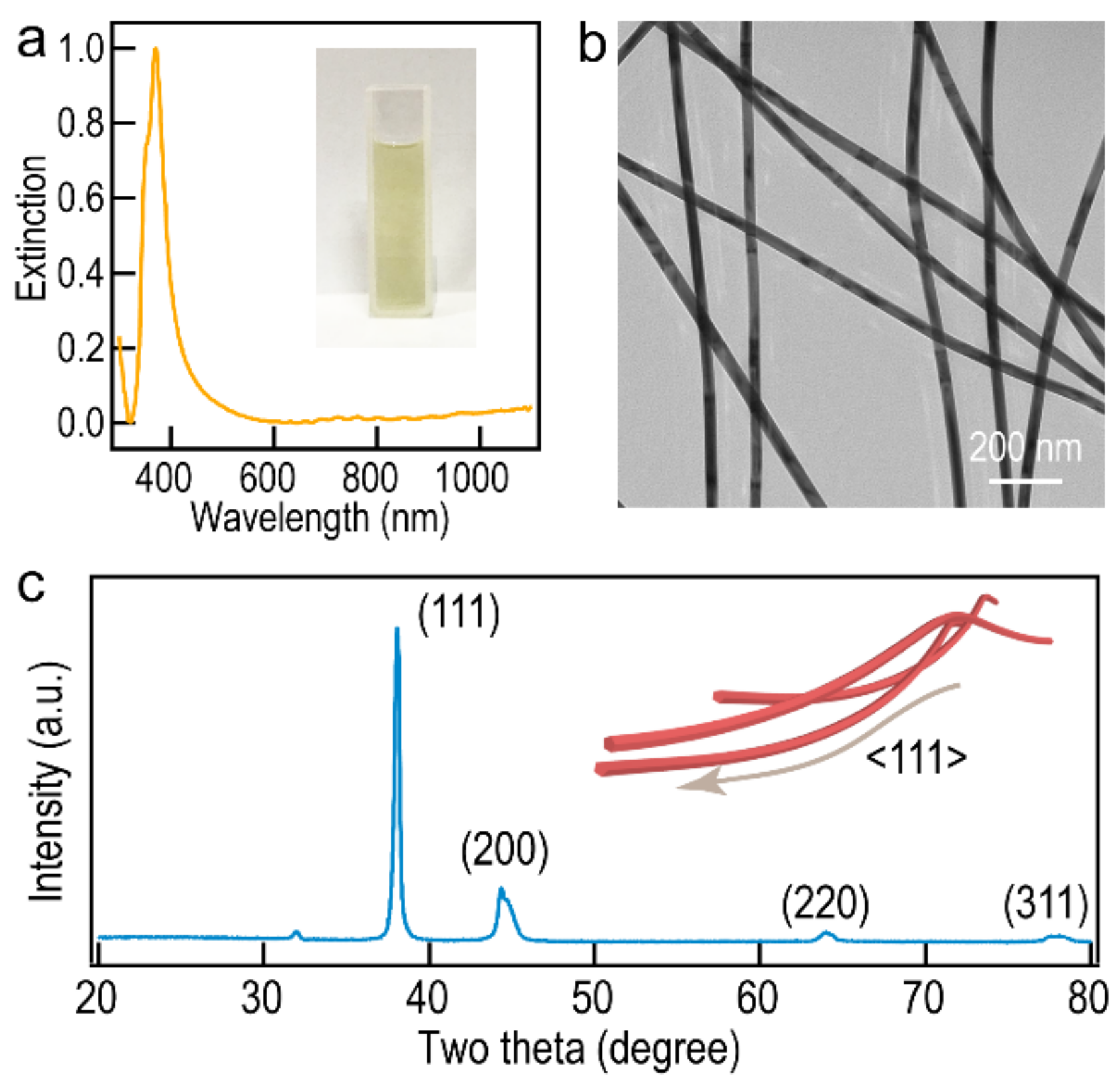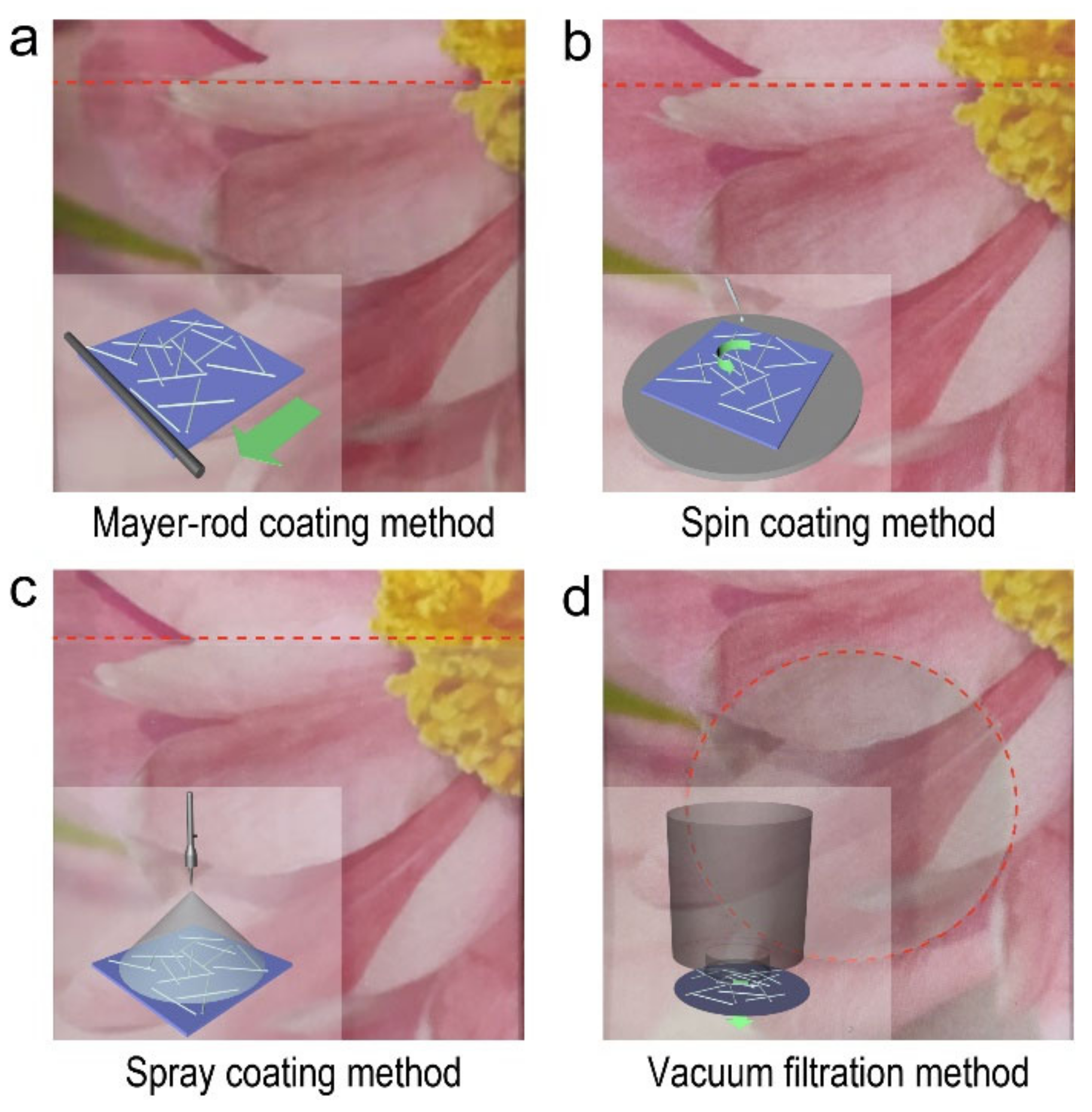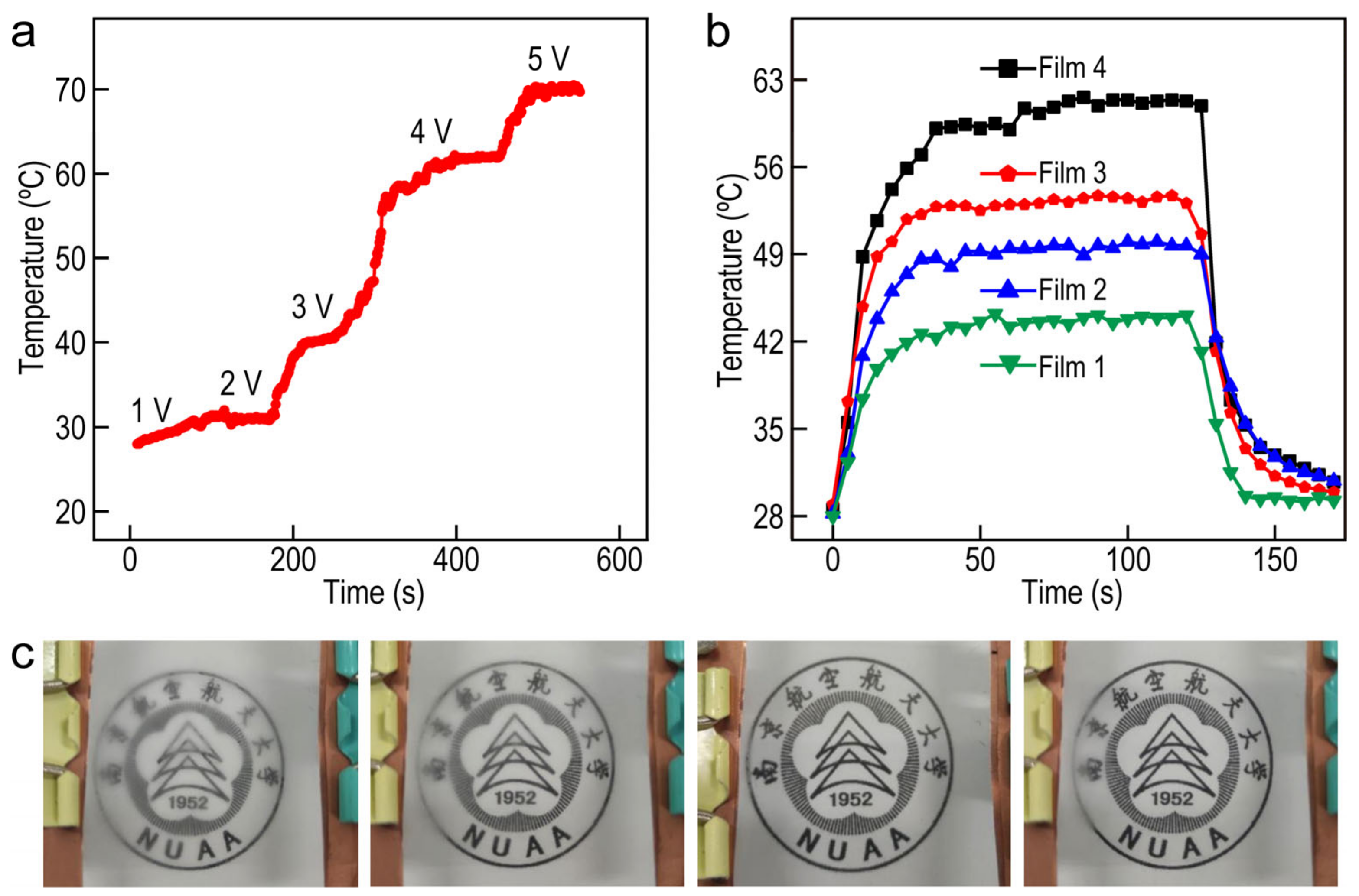Comparative Study on Preparation Methods for Transparent Conductive Films Based on Silver Nanowires
Abstract
1. Introduction
2. Results and Discussion
3. Materials and Methods
3.1. Chemicals
3.2. Preparation and Purification of the Ag NWs
3.3. Fabrication of Ag NW Films by Mayer–Rod Coating Method
3.4. Fabrication of Ag NW Films by Spin Coating Method
3.5. Fabrication of Ag NW Films by Spray Coating Method
3.6. Fabrication of Ag NW Films by Vacuum Filtration Method
3.7. Fabrication of Ag NW/PMMA Films
3.8. Instrument and Characterization
4. Conclusions
Supplementary Materials
Author Contributions
Funding
Institutional Review Board Statement
Informed Consent Statement
Data Availability Statement
Conflicts of Interest
Sample Availability
References
- Im, H.-G.; An, B.W.; Jin, J.; Jang, J.; Park, Y.-G.; Park, J.U.; Bae, B.-S. A High-Performance, Flexible and Robust Metal Nanotrough-Embedded Transparent Conducting Film for Wearable Touch Screen Panels. Nanoscale 2016, 8, 3916–3922. [Google Scholar] [CrossRef] [PubMed]
- Du, H.W.; Wan, T.; Qu, B.; Cao, F.Y.; Lin, Q.R.; Chen, N.; Lin, X.; Chu, D.W. Engineering Silver Nanowire Networks: From Transpare to Resistive Switching Devices. ACS Appl. Mater. Interfaces 2017, 9, 20762–20770. [Google Scholar] [CrossRef] [PubMed]
- Kim, J.-H.; Kim, S.R.; Kil, H.J.; Kim, Y.C.; Park, J.W. Highly Conformable, Transparent Electrodes for Epidermal Electronics. Nano Lett. 2018, 18, 4531–4540. [Google Scholar] [CrossRef] [PubMed]
- Cui, N.; Tang, Q.X.; Ren, H.; Zhao, X.L.; Tong, Y.H.; Liu, Y.C. A Photolithographic Stretchable Transparent Electrode for An All-Solution-Processed Fully Transparent Conformal Organic Transistor Array. J. Mater. Chem. C 2019, 7, 5385–5393. [Google Scholar] [CrossRef]
- Giusti, G.; Consonni, V.; Puyoo, E.; Bellet, D. High Performance ZnO-SnO2: F Nanocomposite Transparent Electrodes for Energy Application. ACS Appl. Mater. Interfaces 2014, 6, 14096–14107. [Google Scholar] [CrossRef]
- Wu, C.-C. Highly Flexible Touch Screen Panel Fabricated with Silver-Inserted Transparent ITO Triple-Layer Structures. RSC Adv. 2018, 8, 11862–11870. [Google Scholar] [CrossRef]
- Jang, S.; Jung, W.-B.; Kim, C.; Won, P.; Lee, S.-G.; Cho, K.M.; Jin, M.L.; An, C.J.; Jeon, H.-J.; Ko, S.H.; et al. A Three-Dimensional Metal Grid Mesh as A Practical Alternative to ITO. Nanoscale 2016, 8, 14257–14263. [Google Scholar] [CrossRef]
- Wu, Z.; Chen, Z.; Du, X.; Logan, J.M.; Sippel, J.; Nikolou, M.; Kamaras, K.; Reynolds, J.R.; Tanner, D.B.; Hebard, A.F. Transparent, Conductive Carbon Nanotube Films. Science 2004, 305, 1273–1276. [Google Scholar] [CrossRef]
- Zhu, W.; Zhang, Y.J.; Zhang, H.; Lv, H.; Li, Q.; Michalsky, R.; Peterson, A.A.; Sun, S.H. Active and Selective Conversion of CO2 to CO on Ultrathin Au Nanowires. J. Am. Chem. Soc. 2014, 136, 16132–16135. [Google Scholar] [CrossRef]
- Wang, Y.; Yuan, Y.L.; Huang, H.W. Recent Advances in Pt-Based Ultrathin Nanowires: Synthesis and Electrocatalytic Applications. Chin. J. Chem. 2021, 39, 1389–1396. [Google Scholar] [CrossRef]
- Tang, H.H.; Feng, H.R.; Wang, H.K.; Wan, X.J.; Liang, J.J.; Chen, Y.S. Highly Conducting MXene-Silver Nanowire Transparent Electrodes for Flexible Organic Solar Cells ACS. Appl. Mater. Interfaces 2019, 11, 25330–25337. [Google Scholar] [CrossRef]
- Leem, D.-S.; Edwards, A.; Faist, M.; Nelson, J.; Bradley, D.D.C.; de Mello, J.C. Efficient Organic Solar Cells with Solution-Processed Silver Nanowire Electrodes. Adv. Mater. 2011, 23, 4371–4375. [Google Scholar] [CrossRef]
- Zhang, L.; Song, T.T.; Shi, L.X.; Wen, N.; Wu, Z.J.; Sun, C.Y.; Jiang, D.W.; Guo, Z.H. Recent Progress for Silver Nanowires Conducting Film For Flexible Electronics. J. Nanostruct. Chem. 2021, 11, 323–341. [Google Scholar] [CrossRef]
- Wang, C.; Xia, K.; Wang, H.; Liang, X.; Yin, Z.; Zhang, Y. Advanced Carbon for Flexible and Wearable Electronics. Adv. Mater. 2019, 31, 1801072. [Google Scholar] [CrossRef]
- Kim, J.; Campbell, A.S.; de Avila, B.E.; Wang, J. Wearable Biosensors for Healthcare Monitoring. Nat. Biotechnol. 2019, 37, 389–406. [Google Scholar] [CrossRef]
- Yu, Z.; Bai, Y.; Wang, J.H.; Li, Y. Effects of Functional Additives on Structure and Properties of Polycarbonate-Based Composites Filled with Hybrid Chopped Carbon Fiber/Graphene Nanoplatelet Fillers. ES Energy Environ. 2021, 12, 66–76. [Google Scholar] [CrossRef]
- Gu, J.; She, J.; Yue, Y. Micro/Nanoscale Thermal Characterization Based on Spectroscopy Technique. ES Energy Environ. 2020, 9, 15–27. [Google Scholar] [CrossRef]
- Li, W.; Zhang, H.; Shi, S.; Xu, J.; Qin, X.; He, Q.; Yang, K.; Dai, W.; Liu, G.; Zhou, Q.; et al. Recent Progress in Silver Nanowire Networks for Flexible Organic Electronics. J. Mater. Chem. C 2020, 8, 4636–4674. [Google Scholar] [CrossRef]
- Kwon, J.; Suh, Y.D.; Lee, J.; Lee, P.; Han, S.; Hang, S.; Yeo, J.; Lee, H.; Ko, S.H. Recent Progress in Silver Nanowire Based Flexible/Wearable Optoelectronics. J. Mater. Chem. 2018, 6, 7445–7461. [Google Scholar] [CrossRef]
- Liu, C.; Lin, Y.; Dong, Y.; Wu, Y.; Bao, Y.; Yan, H.; Ma, J. Fabrication and investigation on Ag Nanowires/TiO2 Nanosheets/Graphene Hybrid Nanocomposite and Its Water treatment performance. Adv. Compos. Hybrid Mater. 2020, 3, 402–414. [Google Scholar] [CrossRef]
- Liu, L.; He, C.; Li, J.; Guo, J.; Yang, D.; Wei, J. Green Synthesis of Silver Nanowires via Ultraviolet Irradiation Catalyzed by Phosphomolybdic Acid and Their Antibacterial Properties. New J. Chem. 2013, 37, 2179–2185. [Google Scholar] [CrossRef]
- Xu, J.; Hu, J.; Peng, C.; Liu, H.; Hu, Y. A Simple Approach to The Synthesis of Silver Nanowires by Hydrothermal Process in The Presence of Gemini Surfactant. J. Colloid Inter. Sci. 2006, 298, 689–693. [Google Scholar] [CrossRef] [PubMed]
- Liu, R.; Wong, F.; Duan, W.; Sen, A. Synthesis and Characterization of Silver Halide Nanowires. Polyhedron 2014, 84, 192–196. [Google Scholar] [CrossRef]
- Jiang, D.; Wang, Y.; Li, B.; Sun, C.; Wu, Z.; Yan, H.; Xing, L.; Qi, S.; Li, Y.; Liu, H.; et al. Flexible Sandwich Structural Strain Sensor Based on Silver Nanowires Decorated with Self-Healing Substrate. Macromol. Mater. Eng. 2019, 304, 190074. [Google Scholar] [CrossRef]
- Cui, Z. Printing Practice for the Fabrication of Flexible and Stretchable Electronics. Sci. China Technol. Sci. 2019, 62, 224–232. [Google Scholar] [CrossRef]
- Zhang, N.; Guo, Q.; Yang, J. The Development of Digital Printing Technologies for Flexible Electronics Devices. Sci. Sin. Phys. Mech. Astron. 2016, 46, 44608. [Google Scholar] [CrossRef]
- Wang, J.; Liu, Y.; Fan, Z.; Wang, W.; Wang, B.; Guo, Z. Ink-based 3D Printing Technologies for Graphene-based Materials: A Review. Adv. Compos. Hybrid Mater. 2019, 2, 1–33. [Google Scholar] [CrossRef]
- Xiao, Y.; Hong, Z.; Zhao, G.C.H.; Liang, R.; Lucas, P.; Hao, Q. Thermal Studies of Three-Dimensional Printing Using Pulsed Laser Heating. ES Mater. Manuf. 2018, 1, 21–26. [Google Scholar] [CrossRef]
- Xia, X.; Xu, X.; Lin, C.; Yang, Y.; Zeng, L.; Zheng, Y.; Wu, X.; Li, W.; Xiao, L.; Qian, Q.; et al. Microalgal-immobilized Biocomposite Scaffold Fabricated by Fused Deposition Modeling 3D Printing Technology for Dyes Removal. ES Mater. Manuf. 2020, 7, 40–50. [Google Scholar] [CrossRef]
- Mei, H.; Ali, Z.; Ali, I.; Cheng, L. Tailoring Strength and Modulus by 3D Printing Different Continuous Fibers and Filled Structures into Composites. Adv. Compos. Hybrid Mater. 2019, 2, 312–319. [Google Scholar] [CrossRef]
- Eda, G.; Fanchini, G.; Chhowalla, M. Large-areu Ultrathin Films of Reduced Graphene Oxide as a Transparent and Flexible Electronic Material. Nat. Nanotechnol. 2008, 3, 270–274. [Google Scholar] [CrossRef]
- Tobjork, D.; Osterbacka, R. Paper Electronics. Adv. Mater. 2011, 23, 1935–1961. [Google Scholar] [CrossRef]
- Ali, M.M.; Maddipatla, D.; Narakathu, B.B.; Chlaihawi, A.A.; Emamian, S.; Janabi, F.; Bazuin, B.J.; Atashbar, M.Z. Printed Strain Sensor Based on Silver Nanowire/Silver Flake Composite on Flexible and Stretchable TPU Substrate. Sens. Actuators 2018, 274, 109–115. [Google Scholar]
- Faddoul, R.; Reverdy-Bruas, N.; Blayo, A. Formulation and Screen Printing of Water Based Conductive Flake Silver Pastes onto Green Ceramic Tapes for Electronic Applications. Mater. Sci. Eng. B-Adv. 2012, 177, 1053–1066. [Google Scholar] [CrossRef]
- Xu, X.; Liu, Z.; He, P.; Yang, J. Screen Printed Silver Nanowire and Graphene Oxide Hybrid Transparent Electrodes for Long-term Electrocardiography Monitoring. J. Phys. D 2019, 52, 455401. [Google Scholar] [CrossRef]
- Finn, D.J.; Lotya, M.; Coleman, J.N. Inkjet Printing of Silver Nanowire Networks. ACS Appl. Mater. Interfaces 2015, 7, 9254–9261. [Google Scholar] [CrossRef]
- Choi, K.; Yoo, J.; Lee, C.K.; Lee, S. All-Inkjet-Printed Solid-state Flexible Supercapacitors on Paper. Energy Environ. Sci. 2016, 9, 2812–2821. [Google Scholar] [CrossRef]
- Zhang, S.; Liu, X.; Lin, T.; He, P. A Method to Fabricate Uniform Silver Nanowires Transparent Electrode Using Meyer-Rod Coating and Dynamic Heating. J. Mater. Sci. 2019, 30, 18702–18709. [Google Scholar] [CrossRef]
- Li, Y.; Cui, P.; Wang, L.Y.; Lee, H.; Lee, H. Highly Bendable, Conductive, and Transparent Film by An Enhanced Adhesion of Silver Nanowires. ACS Appl. Mater. Interfaces 2013, 5, 9155–9160. [Google Scholar] [CrossRef]
- Rahane, G.K.; Jathar, S.B.; Rondiya, S.R.; Jadhav, Y.A.; Barma, S.V.; Rokade, A.; Cross, R.W.; Nasane, M.P.; Jadkar, V.; Dzade, N.Y.; et al. Photoelectrochemical Investigation on The Cadmium Sulfide (CdS) Thin Films Prepared Using Spin Coating Technique. ES Mater. Manuf 2020, 11, 57–64. [Google Scholar] [CrossRef]
- Zhang, Y.; Guo, J.N.; Xu, D.; Sun, Y.; Yan, F. One-Pot Synthesis and Purification of Ultralong Silver Nanowires for Flexible Transparent Conductive Electrodes. ACS Appl. Mater. Interfaces 2017, 9, 25465–25473. [Google Scholar] [CrossRef]
- Ricciardulli, A.G.; Yang, S.; Wetzelaer, G.A.H.; Feng, X.; Blom, P.W.M. Hybrid Silver Nanowire and Graphene-Based Solution-Processed Transparent Electrode for Organic Optoelectronics. Adv. Funct. Mater. 2018, 28, 1706010. [Google Scholar] [CrossRef]
- Lee, S.M.; Lee, J.H.; Bak, S.; Lee, K.; Li, Y.; Lee, H. Hybrid Windshield-Glass Heater for Commercial Vehicles Fabricated via Enhanced Electrostatic Interactions among A Substrate Silver Nanowires and An Overcoating Layer. Nano Res. 2015, 8, 1882–1892. [Google Scholar] [CrossRef]
- Xu, W.; Xu, Q.; Huang, Q.; Tan, R.; Shen, W.; Song, W. Fabrication of Flexible Transparent Conductive Films with Silver Nanowire by Vacuum Filtration and Pet Mold Transfer. J. Mater. Sci. Technol. 2016, 32, 158–161. [Google Scholar] [CrossRef]
- Zhu, X.Z.; Guo, A.Q.; Yan, Z.Y.; Qin, F.; Xu, J.; Ji, Y.D.; Kan, C.X. PET/Ag NW/PMMA Transparent Electromagnetic Interference Shielding Films with High Stability and Flexibility. Nanoscale 2021, 13, 8067–8076. [Google Scholar] [CrossRef] [PubMed]
- Yang, W.; Li, J.; Zhong, Y.; Qian, H.; Li, Z.; Hu, Y. Facile Cl−-mediated hydrothermal synthesis of large-scale Ag nanowires from AgCl hydrosol. CrystEngComm 2013, 15, 2598–2600. [Google Scholar] [CrossRef]
- Ji, Y.H.; Liu, Y.; Huang, G.W.; Shen, X.J.; Xiao, H.M.; Fu, S.Y. Ternary Ag/Epoxy Adhesive with Excellent Overall Performance. ACS Appl. Mater. Interfaces 2015, 7, 8041–8052. [Google Scholar] [CrossRef]
- McCoul, D.; Hu, W.; Gao, M.; Mehta, V.; Pei, Q. Advanced Electronic Skin Devices for Healthcare Applications. Adv. Electron. Mater. 2016, 2, 1500407. [Google Scholar] [CrossRef]
- Serrano, I.G.; Panda, J.; Edvinsson, T.; Kamalakar, V.M. Flexible transparent graphene laminates via direct lamination of graphene onto polyethylene naphthalate substrates. Nano Adv. 2020, 2, 3156. [Google Scholar] [CrossRef]
- Serrano, I.G.; Panda, J.; Denoel, F.; Vallin, Ö.; Phuyal, D.; Karis, O.; Kamalakar, V.M. Two-Dimensional Flexible High Diffusive Spin Circuits. Nano Lett. 2019, 19, 666–673. [Google Scholar] [CrossRef]
- He, L.; Tjong, S.C. Nanostructure Transparent Conductive Films: Fabrication Characterization and Applications. Mater. Sci. Eng. R 2016, 109, 1–101. [Google Scholar] [CrossRef]
- Lee, H.; Hong, S.; Lee, J.; Suh, Y.D.; Kwon, J.; Moon, H.; Kim, H.; Yeo, J.; Ko, S.H. Highlt Stretchable and Transparent Supercapacitor by Ag-Au Core-Shell Nanowire Network with High Electrochemical Stability. ACS Appl. Mater. Interfaces 2016, 8, 15449–15458. [Google Scholar] [CrossRef]
- Ge, Y.; Duan, X.; Zhang, M.; Mei, L.; Hu, J.; Hu, W.; Duan, X. Direct Room Temperature Welding and Chemical Protection of Silver Nanowire Thin Films for High Performance Transparent Conductors. J. Am. Chem. Soc. 2018, 140, 193–199. [Google Scholar] [CrossRef]
- Kang, H.; Song, S.J.; Sul, Y.E.; An, B.S.; Yin, Z.; Choi, Y.; Pu, L.; Yang, C.W.; Kim, Y.S.; Cho, S.M.; et al. Epitaxial-Growth-Induced Junction Welding of Silver Nanowire Network Electrodes. ACS Nano 2018, 12, 4894–4902. [Google Scholar] [CrossRef]






Publisher’s Note: MDPI stays neutral with regard to jurisdictional claims in published maps and institutional affiliations. |
© 2022 by the authors. Licensee MDPI, Basel, Switzerland. This article is an open access article distributed under the terms and conditions of the Creative Commons Attribution (CC BY) license (https://creativecommons.org/licenses/by/4.0/).
Share and Cite
Zhang, J.; Zhu, X.; Xu, J.; Xu, R.; Yang, H.; Kan, C. Comparative Study on Preparation Methods for Transparent Conductive Films Based on Silver Nanowires. Molecules 2022, 27, 8907. https://doi.org/10.3390/molecules27248907
Zhang J, Zhu X, Xu J, Xu R, Yang H, Kan C. Comparative Study on Preparation Methods for Transparent Conductive Films Based on Silver Nanowires. Molecules. 2022; 27(24):8907. https://doi.org/10.3390/molecules27248907
Chicago/Turabian StyleZhang, Jizhe, Xingzhong Zhu, Juan Xu, Ruixing Xu, Hao Yang, and Caixia Kan. 2022. "Comparative Study on Preparation Methods for Transparent Conductive Films Based on Silver Nanowires" Molecules 27, no. 24: 8907. https://doi.org/10.3390/molecules27248907
APA StyleZhang, J., Zhu, X., Xu, J., Xu, R., Yang, H., & Kan, C. (2022). Comparative Study on Preparation Methods for Transparent Conductive Films Based on Silver Nanowires. Molecules, 27(24), 8907. https://doi.org/10.3390/molecules27248907





